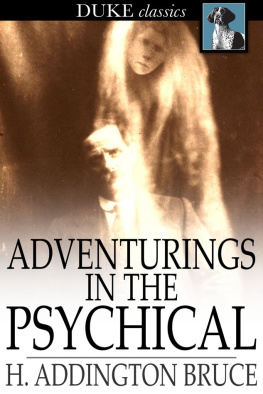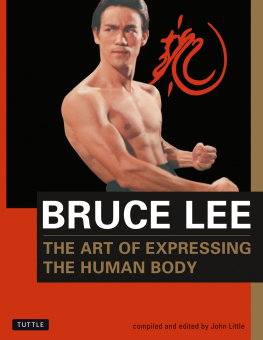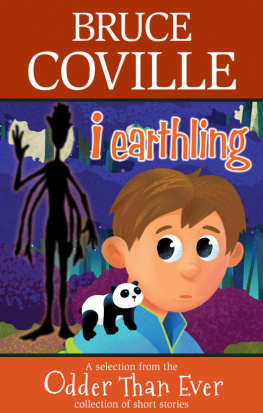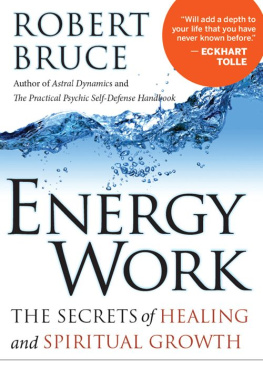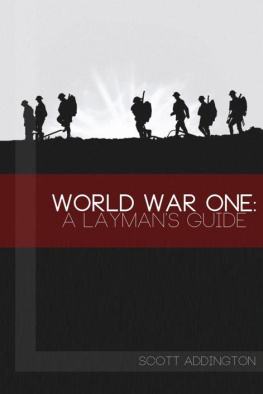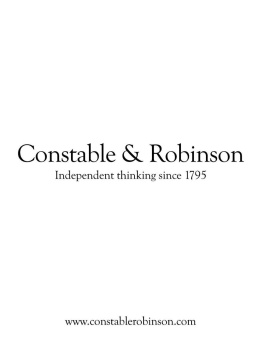ADVENTURINGS IN THE PSYCHICAL
* * *
H. ADDINGTON BRUCE
*
Adventurings in the Psychical
First published in 1914
ISBN 978-1-63421-230-4
Duke Classics
2014 Duke Classics and its licensors. All rights reserved.
While every effort has been used to ensure the accuracy and reliability of the information contained in this edition, Duke Classics does not assume liability or responsibility for any errors or omissions in this book. Duke Classics does not accept responsibility for loss suffered as a result of reliance upon the accuracy or currency of information contained in this book.
Contents
*
Preface
*
The present volume is somewhat in the nature of a sequel to "The Riddleof Personality," published six years ago. In that book I reviewed theresults of modern psychological research in the realm of the abnormaland the seemingly supernormal, with the special purpose of making cleartheir bearings on the problem of the nature and possibilities of man.Having this special purpose in mind, it was inadvisable to attempt anytopical and detailed treatment of the phenomena made the subject ofscientific investigation. Such a method of treatment, no matter how itmight have added to the interest of the book, would inevitably haveobscured its message to the reader.
Now, however, I have undertaken this very thing, in the hope both ofreinforcing the view of personality set forth in the earlier work, andof contributing something towards a wider knowledge of the progressscience is making in the naturalization of the supernatural, to borrowMr. Frank Podmore's happy phrase. Especially have I tried to bring outthe exceedingly practical character of many of the discoveries made bythose scientists who, despite the often contemptuous criticism of theircolleagues, have valiantly persisted in their adventurings in thepsychical. The world has undoubtedly been the gainer, and richly thegainer, by their labors; and it surely is well worth while to surveyin some detail the field they have explored and the results of theirexplorations.
H. ADDINGTON BRUCE.
CAMBRIDGE, MASSACHUSETTS,
February, 1914.
Chapter I - Ghosts and Their Meaning
*
A witty Frenchwoman was once asked if she believed in ghosts.
"No, not at all," was her reply. "But I am terribly afraid of them."
Most people feel precisely this way about ghosts, though few are candidenough to acknowledge it. In broad daylight, or when seated beforea cheery fire among a group of congenial friends, it is easy to beskeptical, and to regard ghosts as mere products of imagination,superstition, credulity, hysteria, or indigestion. But it is notoriousthat even the most skeptical are liable to creepy sensations andsometimes outright panic if they experience "uncanny" sights or soundsin the darkness of the night, or in lonely, uninhabited places.Churchyards have never been popular resorts of those who go for a strollin the cool of the evening. And let a house once get the reputation ofbeing "haunted," it is next to impossible to find tenants for it.
Yet this almost universal attitude is entirely and fundamentally wrong.There is no reason for being afraid of ghosts, and there are manyreasons for believing in them.
I do not, of course, mean to say that all ghosts are real ghosts. Thereare plenty of bogus ghosts, and there always will be, as long as men eatand drink too much, play practical jokes on one another, and allow theirhouses to become run down and infested by rats and mice.
A single rat, scampering at midnight over the loose planks of anold attic, has often been quite sufficient to produce a counterfeit"poltergeist," or troublesome ghost, of a highly impressive character.So, too, a pillow-slip swaying from a clothesline is apt to seem mostghostly to a gentleman returning home from a late supper. Ghosts, likemuch else in this amazing world of ours, have to be pretty sharplyscrutinized.
And the point is that, after centuries of contemptuous neglect, theyhave at last been made the subject of investigation by men and womencompetent for the taskpersons trained in the cautious methods ofscientific inquiry, and insisting upon the strictest evidentialstandards, but devoid of prejudice or prepossession. Their researchesare still in progress, but they have already demonstrated that amid amultitude of sham ghosts there are perfectly authentic apparitions,displaying credentials too convincing to be denied.
What is still more important, the labors of these scientificghostologistsespecially of those enrolled in the famous EnglishSociety for Psychical Researchhave also resulted in throwing muchlight on the nature, origin, and habits of real ghosts.
Usually, it seems, a genuine ghost is seen or heard but once or twice,and then, having accomplished its purpose, it departs to return no more.But there are plenty of well-attested cases in which a ghost attachesitself to a house or family, and keeps up its haunting for years,sometimes for centuries.
Take, for example, an experience that befell Miss Goodrich-Freer, atthe time a most active member of the Society for Psychical Research, inHampton Court Palace. This old building is unquestionably one of themost famous of all haunted houses. It dates back to the time of thefirst Tudors, and according to tradition is haunted by several ghosts,notably the ghosts of Jane Seymour, Henry VIII's third queen; CatharineHoward, whose spirit is said to go shrieking along the gallery where shevainly begged brutal King Henry to spare her life; and Sybil Penn, KingEdward VI's foster-mother. Twice of late years the Howard ghostorsomething that passed for ithas been heard, once by Lady Eastlake, andonce by Mrs. Cavendish Boyle. The latter was sleeping in an apartmentnext to the haunted gallerywhich has long been unoccupied and usedonly as a storeroom for old pictureswhen she was suddenly awakened bya loud and most unearthly shriek proceeding from that quarter, followedimmediately by perfect silence. Lady Eastlake's experience was exactlysimilar.
Both ladies, of course, may have heard a real shriek, possibly comingfrom some nightmare-tormented occupant of the palace. But no explanationof this sort is adequate in the case of Miss Goodrich-Freer, who passeda night at Hampton Court for the sole purpose of ascertaining whether ornot there was any foundation for its ghostly legends.
The room she selected for her vigil was one especially reputed to behaunted, and opened into a second room, the door between the two,however, being blocked by a heavy piece of furniture. Thus the onlymeans of entrance into her room was by a door from the corridor, andthis she locked and bolted. After which, feeling confident that nothingbut a real ghost could get in to trouble her, she settled down toread an essay on "Shall We Degrade Our Standard of Value?" a subjectmanifestly free from matters likely to occasion nervousness.
In fact, the essay was so dull that by half past one MissGoodrich-Freer, not able to keep awake longer, undressed, dropped intobed, and was almost instantly asleep. Several hours later she wasaroused by a noise as of some one opening the furniture-barricaded door.At this she put out her hand to reach a match-box which she knew waslying on a table at the head of the bed.
"I did not reach the matches," she reports. "It seemed to me that adetaining hand was laid on mine. I withdrew it quickly and gazed aroundinto the darkness. Some minutes passed in blackness and silence. I hadthe sensation of a presence in the room, and finally, mindful of thetradition that a ghost should be spoken to, I said gently: 'Is any onethere? Can I do anything for you?' I remembered that the last person whoentertained the ghost had said: 'Go away, I don't want you,' and I hopedthat my visitor would admire my better manners and be responsive.However, there was no answer, no sound of any kind."

